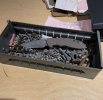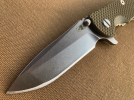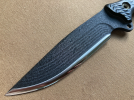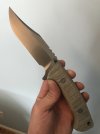I can tell you pretty confidently that you definitely dropped well below 15 DPS on that one because I just did one recently for a customer at that edge geometry and never even came close to scratching the primary grind (which is probably no more than 10 DPS primary grind at the tanto tip itself). You'll need some kind of an acid solution to darken the scratch pattern you put on the knife but it's not entirely necessary as that's a cosmetic thing only. I would say if you wanted to try and even out the edge bevel the thing to do would be to lower the edge angle at the straight portion of the edge to make an similar with as the tip portion.
That was my thought but want to make sure I'm not missing something. At that transition what is happening is the thickness behind the edge is dramatically thicker than on either side of the transition so you get a widening effect there. You won't notice as much with factory edge bevel being so much more obtuse and there's more margin for hiding this.
I know many people here consider a really high quality sharpening job to be one where it has a beautiful polish and perfect symmetry/edge width along the entire edge bevel but that actually matters far less than what is going on at the very apex and whether or not you've got appropriate geometry for what you intend to cut. That knife I did for a customer was a good example of this. The comment that it looks 'wonky' is OK with me, I was upfront with the customer that my sole focus on this was performance for the price we agreed upon = little attention given to aesthetics other than trying to get an even bevel within reason. You can even see two distinct bevels, the apex bevel scratches run at a bit of a different direction from the main edge bevel. This is because I raised the edge angle by one degree in order to grind only the apex in a way that cuts the apex cleanly without forming additional burr at the same time.
The apex on this knife has it going on in all the right places where it counts though. This is 15 degrees per side edge geometry finished off a 220 grit Tormek wheel exclusively (no strops, no deburring block, no other stones, etc) and the result is that it has both high push cutting sharpness (pops arm hairs) and high slicing aggression and edge retention. This is a difficult thing to pull off and basically requires that you finish on a very coarse stone... which is going to leave heavy scratches which are obvious and possibly look bad. You also have to know how to remove the burr cleanly to get to undamaged steel and refine that apex with a light touch. Lower edge angle than factory equals wide bevel in all cases (without a regrind)
The customer was VERY happy with the result here and told me that he'd be sending me future work.
https://www.bladeforums.com/threads/father-and-son-sharpening.1918713/
View attachment 2127805
As an interesting comparison here's a knife that I received a while back that looked very nice because of the mirror polish on the lower portion of the convex bevel but had a very unfortunate reality at the apex. There was a VERY prominent burr at the actual apex (likely from buffing). That combined with the high polish pretty much means this is not going to perform well for push cutting or slicing work. If you had to ask most people which they'd prefer, I would suggest the likely answer would be this example based on looks alone. Actually having a chance to use them would be a very different story and looks can be deceiving.
View attachment 2127807













